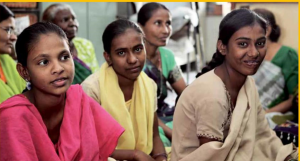The blog highlights the challenges and opportunities in women´s financial inclusion in Bangladesh and also examines how the women’s specific financial needs in relation to men’s.
Financial inclusion benefits individuals and households, and well-functioning financial systems benefit whole countries. Nevertheless, access to financial services is highly unequal, with poor people – and particularly poor women especially in countries like Bangladesh– frequently the least served by existing institutions and systems.
What is women’s financial inclusion?
Women‘s financial inclusion occurs when women have effective access to a range of financial products and services (e.g. Save money safely, send and receive money securely, insure against risk, tailor made loan schemes etc.) that cater to their multiple business and household needs and that are
responsive to the socioeconomic and cultural factors that cause financial exclusion in women and men to have different characteristics.
Financial inclusion can increase the empowerment of women in a number of ways. Firstly, having access to resources on their own account and to the tools that help them to earn a living can increase women’s bargaining power within households and their influence over how money and other resources are used. Secondly, financial inclusion can help increase women’s opportunities to earn an income or control assets outside the household. Thirdly, it can reduce women’s vulnerability by, for example, allowing them to insure against risk or borrow to meet unexpected expenses, such as medical treatments. These are all key factors for economic empowerment and they can also help to empower women more broadly.
Typically, barriers to financial inclusion (FI) are categorized as ‘supply’ or ‘demand’ side. These may affect women more than men, or affect them differently from men, but in some measure they will affect both men and women, and especially poor men and women. Of course, supply and demand side barriers can reinforce each other, notably around affordability where it may be difficult to determine which is the greater barrier, the cost of the financial product or the income of the person wanting to buy it. Research has indicated that many more people cite demand-side barriers, rather than supply-side barriers, as the reason why they do not engage with formal financial services. But both matter and it is the relationship between the two that largely determines the extent and quality of access. Income poverty (the primary demand-side constraint) is the reality in which financial inclusion operates and, depending on the particular issue. The importance of demand side research on women’s financial inclusion in Bangladesh cannot be underestimated. The way women manage their money has been a much more private (and often domestic) undertaking in comparison to the
way men manage their money. Intra-household dynamics have sometimes obliged women to manage their income and savings with great secrecy. As regards enterprise finance, all SMEs, regardless of the gender of their owner, can face many major barriers to accessing credit, although some barriers have a disproportionately negative impact on women entrepreneurs. These include: record keeping issues; limited financial awareness and literacy levels; lack of ownership of acceptable collateral (e.g. where banks have a high preference for land and buildings, cash and some types of equipment); the cost of credit; negative perceptions of banks; risk aversion; gender discrimination; and cultural constraints on women entrepreneurs. Furthermore, because women entrepreneurs tend to run smaller businesses than men, this puts them at a disadvantage when accessing bank finance because banks tend to prefer larger loan sizes.
In the next blog, I will share my experience in designing a monitoring and evaluation framework (and why it’s important) for an access to finance project in Bangladesh.

Reference:
- Esplen and Brody (2007). ‘Putting Gender Back in the Picture: Rethinking Economic Empowerment’. BRIDGE BB19
- Jones (2012). Discussion Paper for an M4P Women’s Economic Empowerment Framework.
- www.afi-global.org
- Genesis Analytics (March 2008), an investigation into the 2% affordability threshold for transactional banking, for the FinMark Trust.
About the Author

Zubair holds a master’s degree in Biomedical Engineering from the University of Magdeburg in Germany. Currently he is working as Research Analyst at Consiglieri and managing Consiglieri’s Monitoring and evaluation projects including Business Finance for the Poor in Bangladesh (A £25m facility to create economic opportunities for small businesses). Before joining Consiglieri, he worked extensively in research and development in various international institutions and organizations such as IMOS at Germany, ASML at Netherlands and University of Dhaka at Bangladesh. He has been granted scholarships and awards during his study work at University of Magdeburg, Germany, International Science Programme (ISP) Fellowship by Uppsala University, Sweden and ICT Fellowship by the Government of Bangladesh. Zubair has several scientific publications at national and international journals.
Bridging the Financial Inclusion Gender Gap: Insights from Promoting Women’s Financial Inclusion

